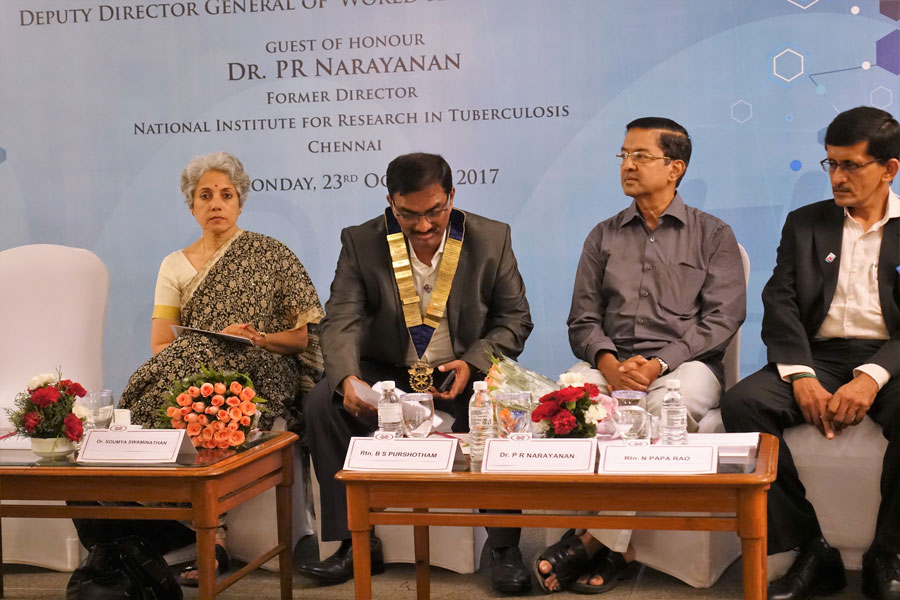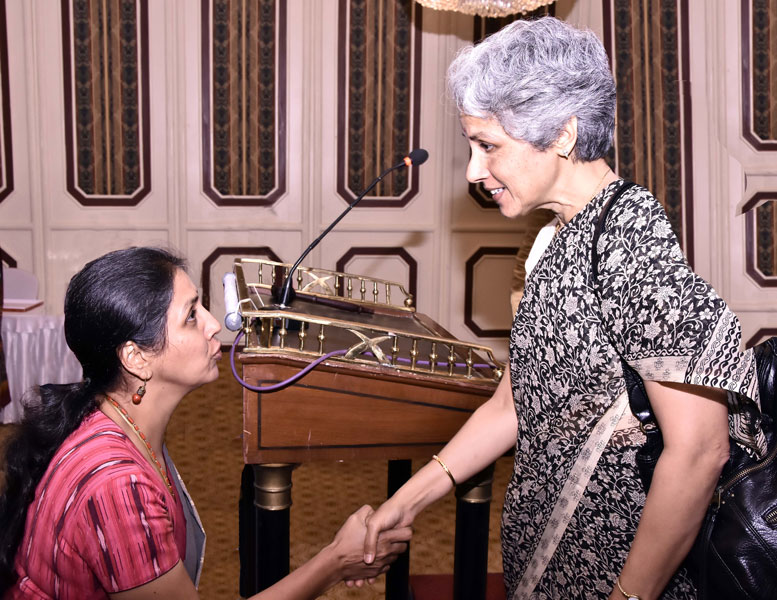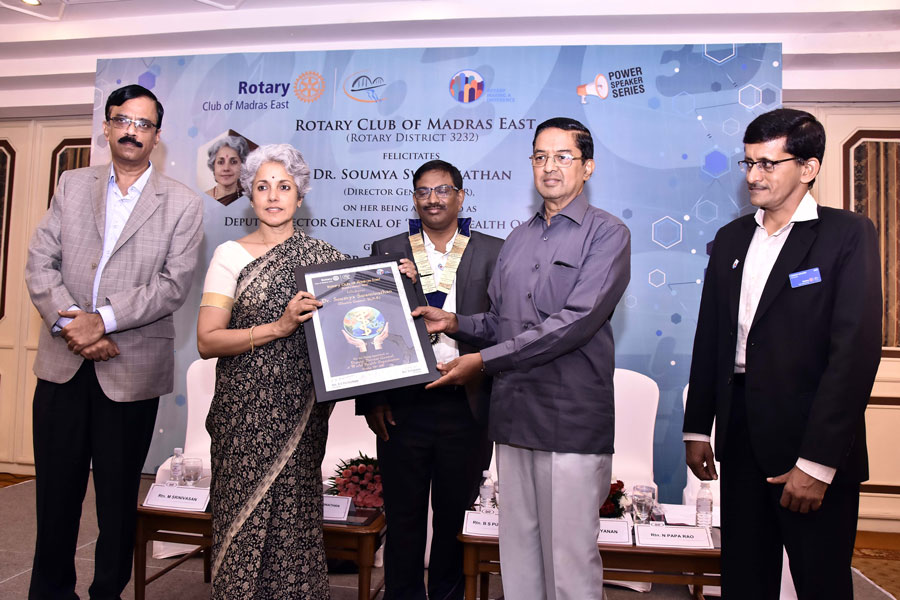Let RI take up the challenge of eradicating TB: Soumya Swaminathan

Now that Rotary and Rotarians have scored such a huge victory in ridding India of polio, it is time “Rotary International takes up as its next big challenge the eradication of tuberculosis, a huge problem that affects disproportionately countries that are poor.”
This suggestion was made by Dr Soumya Swaminathan, the Director General of ICMR (Indian Council for Medical Research) when she was felicitated recently by the Rotary Club of Madras East, D 3232, on her being appointed as the Deputy Director General of WHO. This is the highest international position held by an Indian in the health care segment.
Addressing the club meeting where her illustrious parents — Dr M S Swaminathan, an honorary member of this club, and Dr Mina Swaminathan —
were present, she traced her career in research and health care and said that over the last 25 years, India “has made a huge progress in health care. And in this, the eradication of polio is a very big, perhaps the biggest success story, in which Rotary played a huge role internationally. And you must now look for the next big global challenge, because the success of polio showed you need partnerships.”
When you are a young scientist you are not very clear on what your particular area or path should be. You need a mentor and a guide who will push you in the right direction and give you the space and freedom.
Any campaign needed the government, but also the civil society and “in polio, mobilisers like the Rotary clubs, media, big funders like the Gates Foundation, and of course, scientists came together.” Science made a huge contribution in the polio success through the work on vaccines — “how they work, how many doses should be given, at what age, when to replace one vaccine with another, how to monitor the environmental samples for traces of wild poliovirus.” But in motivating people to go out and give polio drops Rotary had contributed a lot.
TB a huge challenge in India
Dr Soumya said that among the poorer countries India had the largest burden of tuberculosis cases. “There cannot be a global eradication of TB without India making a big dent. Of the ten million new cases of TB detected every year, we are contributing at least three million, if not more.” The biggest risk factor in India for TB today was malnutrition and not HIV, which is the factor responsible in Africa. “There are tribal areas where every family has a TB patient; the story is similar in urban slums, where TB is not diagnosed in time.”

Calling upon the Rotary clubs in Chennai to join hands with her in the initiative TB-free Chennai in which she was associated, Dr Soumya said after discussions for several years it had finally been recently inaugurated by the Tamil Nadu Chief Minister E Palanisami. It is a people’s movement where several agencies have come together “to show that we can get rid of TB in at least one city of over eight million people.” The initiative was led by the Chennai Corporation, in partnership with the ICMR and the NGO Reach founded by Dr Nalini Krishnan and other NGOs who would be the link between the programme and private physicians as many TB patients are with the private sector.
Several celebrities had come on board as advocates such as actors Surya and Suhasini Maniratnam “who wrote to me saying what can
I do for TB; I’ve had it twice. Amitabh Bachchan is a national icon who has had TB, which doesn’t spare anyone. I know of medical students who died of drug resistant TB.”
The ‘neglected disease’
She underlined the need to involve the media, “and be open with them and give them correct information” on any health care subject. Or else the wrong kind of news gets highlighted. “Science communication in our country is still in its infancy; it’s growing but we need more journalists to report on science.” Unfortunately, bad news always makes it to the headlines, Dr Soumya said, and gave the example of how every year, during the dengue epidemic “the TV channels flash 3 or 7 died in 24 hours. I tell them during the same period 1,000 people died on tuberculosis in India, why is nobody reporting on that.”
If at the school level children get opportunities to explore things, do their own tests in the lab and feel they are discovering something new, it triggers early interest, which can potentially result in a career in research.
This was so because it had been happening for long and not in Delhi, Mumbai or Chennai but in some remote places and “these people are not important; that is why TB is called the ‘neglected disease’. I’m involved because I’m trying to create a clean and safe environment for children to grow up in, and take one disease and show it is possible to eliminate it. If Chennai can do it, so can the rest of India. Rotary has taken many challenging projects in the past, and this is a very challenging job that requires concerted efforts for a minimum of five years.”
Down memory lane
Responding to TB veteran Dr P R Narayanan’s introduction, Dr Soumya said, “By now he must be getting fed up of introducing me but he does it patiently; he knows me extremely well. Most of my career was spent under
Dr Narayanan’s mentorship and whatever I have achieved wouldn’t have been possible without it, because when you are a young scientist you are not very clear on what your particular area or path should be. You need a mentor and a guide who will push you in the right direction and give you the space and freedom and encouragement to go ahead.”
She said we in India need to introspect on why India is not really a global leader in research, particularly medical and health care research. “Except for space, where I think we’ve done exceedingly well and made a mark, in other areas, I think we can do much better.”

She recalled that her first real research came after she got a science talent award in Class 11. She spent her summer holidays with Prof Archana Sharma, a very well-known geneticist and her research was on the genetic chromosomal disease called Turners syndrome. At the hospital she met a 16-year-old girl who had not yet achieved puberty, took her blood sample and did the tests in Prof Archana’s lab. “This was very exciting as the diagnosis could be made immediately because one X chromosome was missing. A girl is supposed to have two X chromosomes; against a boy having one X and one Y chromosome. Because of the missing X chromosome, such girls can’t attain puberty and have a normal reproductive life.”
That really kindled her interest in research. If at the school level children get opportunities to explore things, do their own tests in the lab and feel they are discovering something new, it triggers early interest, which can potentially result in a career in research. That is probably missing in many of our schools. There is no opportunity for children to try things on their own and find things for themselves.”
Research mentorship missing
Secondly, much later in her education, she really missed, in India, research mentorship. So during medical school and even in PG, “when you do your thesis, it wasn’t particularly exciting. But when I went to the US for my Fellowship there, I had excellent research mentors and that’s where I learnt most of my research. It is very important to have somebody who can guide you on what exact research question to ask, how to frame it and go about answering it.”
In the beginning you need to know what exact research question to ask, how to frame it and go about answering it. In the US,
I had excellent research mentors, something that is lacking in India.
Later of course she got a mentor in Dr Narayanan. Dr Soumya recalled that when she was working on a tuberculosis project at the TRC (Tuberculosis Research Centre) and would visit the very backward tribal village in the Javadhu hills, “I noticed that the mothers had a completely different concern. They’d ask why do you come and keep talking about TB all the time. Once a year somebody might have TB; we have so many other health problems, but you are not bothered. The whole team comes and talks about TB, you find that one patient and then leave. You’re not helping us with our other health needs. If somebody has a fracture, we have to carry him for three days before we reach a primary health centre.”
This set her thinking that “while we as researchers have our own ideas, that’s not what the people really want, their priorities are different. And so, when you deal with public health it is important to find out what people actually need.”
Her work in HIV/AIDS
Another important lesson she learnt was during her work in HIV/AIDS, when the first six cases were discovered by Dr Suniti Solomon in some sex workers from Mumbai. HIV infection carried a huge stigma and nobody would touch the infected, who were all sent to the TB Sanatorium at Tambaram, which later became the largest hospital in Asia for HIV/AIDS patients.
“Many people were thrown out of their homes, and faced stigma and even violence and had nowhere to go. The wards here were filled with AIDS patients dying of all sorts of complications. I then saw what is stigma and what it can do to families. How women got blamed when the husband died of AIDS and what happened to the children with HIV when the parents died.” Very few medical teams were prepared to take care of these patients, so “we started looking after them with some support from NGOs who donated drugs. Many of the children died, but some did survive and did well. I still meet some of those children who are in their 20s and who got educated.”
Unfortunately, bad news always makes it to the headlines; TV channels flash 3 or 7 died in dengue in 24 hours, but not 1,000 people dying of tuberculosis in the same period.
So in the case of HIV and AIDS it was not only about research, prevention and treatment but also dealing with the social aspect, the stigma and a lot of misconceptions on how HIV spread, and the rumours of the modes of transmission of the virus and how protection was necessary. But over the last 25 years, India had made huge progress on the health care front, she added.
Lifestyle diseases
Other huge problems facing India were lifestyle diseases such as diabetes, and preventable diseases that were water-borne and could be contained through cleanliness, hygiene and safe drinking water. Diabetes, she said, is a huge concern in India. “We are either eating too much or eating the wrong kind of food; too much of carbohydrates, lots of salt and sugar, getting hidden and unnecessary calories. We have moved away from traditional foods like millets and are eating a lot of processed food, and exercise less. Diabetes is a huge epidemic leading to other complications like stroke, kidney, cardio vascular and other complications, and the situation can be corrected only by preventive measures — changing lifestyle and reducing risk factors such as alcohol and tobacco.”
Another worrying statistic from India, said Dr Soumya, was the increasing rate of suicide, which was today the “the leading cause of death in the 15–29 age group in India. Why are young people killing themselves? They are not able to cope with depression and other pressures. And now there is the internet addiction and things like the Blue Whale Challenge!”
Malnutrition too was a big problem; 38 per cent of our children under five are stunted, with both their height and intellectual capacity affected, but in urban India obesity was growing and chronic diseases increasing. “So we live in two Indias — the poor can’t even afford a balanced meal and the rich have diseases like diabetes.”
Past president of the club M Srinivasan introduced Dr Soumya and Club President B S Purushotham presided over the meeting.
A mentor’s introduction
Dr Soumya’s elevation to this post is a very special moment for her family, colleagues, seniors and mentors such as Dr P R Narayanan who was the Director of the Tuberculosis Research Centre (now the National Institute for Research in Tuberculosis) and worked with her for long years. Complimenting her for becoming the Deputy Director General for Programmes in the WHO, he said with pride: “No Indian has ever occupied such a senior positon in a world health body, but then Soumya is a globally recognised researcher on TB and HIV/AIDS. So how did she achieve it? Was she given a golden spoon and a silver plate overlooking her peers in the places she worked? No, I assure you that is not the case,” he said.
He recalled that in 1992, when she joined TRC (now NIRT), “she came into a situation that was not bright. Typically, in government institutions staff complain of lack of elbow room, facilities… I can say this confidently. But here is a woman highly qualified from prestigious institutions in the north and having an exposure to institutions in Europe and USA. Instead of complaining, she started focusing on patient care from day 1 with all the patience required.”
When he became the institution’s director in 1996, there was a pressing need for someone to handle the HIV area “and I chose Soumya because of her willingness and commitment to start a department of HIV/AIDS. Within a short period, she formed an excellent team and came forward with some pioneering research in both TB and HIV. This resulted in scientific publications in peer review journals. So the world recognised her as a potential researcher and a care provider.”
But, added Dr Narayanan, despite having reached great heights in TB and HIV/AIDS research, she did not lose focus on her basic training in paediatrics at any time. He narrated the story of how he’d take his staff to a tribal area in the Javadhu hills near Vellore in Tamil Nadu. “But when we reached the location, Soumya would be missing from the room and could be seen surrounded by a huge group of tribal women and children, consulting her on a host of problems. Patiently, and most important for a doctor, compassionately, which is much more important today, and gracefully, which we find missing most of the time, she would address their demands within the framework of what is permissible in a research institution. She became so popular as a paediatrician in those tribal areas that every time the tribal people would expect her to be part of the team!”
Dr Narayanan said that he was the chair of the technical working group of WHO for seven years for the South East Asian region and Dr Soumya would attend these meetings and “always raise her voice repeatedly, year after year, to pay attention to the diagnosis and management of children with TB.”
Soon international organisations started noticing her and wanted her to address issues related to global health. Her ability to create an excellent team and sustain it; her contribution to the policies for disease control programmes, her global exposure by being in international committees was soon noticed by the Indian authorities. “I can assure you that she did not make any efforts at visibility but the world saw her work and has recognised her merit, research and extraordinary qualities of leadership. No wonder she was given the Director General’s post in the Ministry of Health and the ICMR and made a Health Secretary.”
He added that during her two years at the ICMR she launched several key projects, very boldly merged various small arms of the ICMR to make it more cost effective and cohesive, and recruited a large number of young talented scientists, who had been missing for a long time. “She had the ability to mobilise the resources from the Ministry to do that.”
He also stressed on her ability to coordinate, cooperate and collaborate with larger institutions such as the Department of Biotechnology, Science and Technology, etc to carry forward the TB control programme and still contribute as a paediatrician and provide care to the community. “All this was now noticed by international forces and the DG of WHO probably noticed her capability as a quality researcher, collaborator, policy maker, field worker, etc and invited her on October 12 to occupy the DDG chair of WHO.”
He explained that the DG of WHO has presently formed a new team with members from 14 countries of the WHO region and “this new team comprises former ministers of health, world’s leading physicians, scientists, researchers, experts in universal health coverage, communicable and non-communicable diseases and women, adolescent and children’s health.”
Dr Narayanan concluded saying that having worked with Dr Soumya, “discussing, debating, negotiating, not always agreeing… most of the time disagreeing, I found her to be a true and genuine professional. No wonder the world wants her to address health issues globally… knowing her well I am sure she will meet its expectations and without expecting much in return!”

